The Carnian Pluvial Episode, CPE
-That Time It Rained for 2M Years -
Cat: SCI
Pub: 2018
#:2407
PBS EONS
249080u
Title
The Carnian Pluvial Episode, CPE
Index
Tag
Source (2024/9): https://www.youtube.com/watch?v=_1LdMWlNYS4;
Why
- Some people have a cynical view of global warming as a hypothesis or even a conspiracy theory; They have short-sighted view who wold not try to understand the actual events occurred in the long Earth history.
- There is more clear and intense evidence of global warming in the history of the Earth. It is called as CPE (Carnian Pluvial Episode) occurred in the Mesozoic Period; only a short period of rainfall period (lasted only two million years) during the long 200 million years of Mesozoic Period.
- Dinosaurs diversified and flourished through this turbulent period of abnormal rainy weather, and in their shadow we mammals were born.
- 地球温暖化は、仮説であるとかあるいは陰謀説といううがった見方がある。彼らは長い地球の歴史で実際に起こった出来事を理解しようとしない近視眼的な見方の人たちである。
- 地球の歴史の中でもっと明白で強烈な地球温暖化の証拠があるのだ。それはCPE (カーニアン多雨現象")といわれる約2億年続く中生代 (255 -67ma)中でのわずか2百万年の多雨の時期による地球温暖化現象である。
- その異常気象の激動中で、恐竜は多様化し繁栄して、その影で我々哺乳類が誕生したのだ。
Category
LaTeX command
LaTeX Sample
>Top 0. Preface:
- A. Ruffell, J. Dal Corso, and M. Benton found that the Triassic Epoch of Extraordinary Precipitation (CRE) was the cause of a major upheaval in life.
- The CRE is was a period of extremely high rainfall for just 2 million years in the 50.6 million year Triassic Period (251.9 Ma - 213.0 Ma).
- Large-scale volcanic activity occurred in the ocean, and the deoxygenation of the oceans caused a mass extinction of marine organisms (such as ammonites and conodonts), while caused the appearance of mammals and the diversification of dinosaurs on land.
12. 序文:
- A. Ruffell, J. Dal Corso, M. Bentonは、三畳紀の一時的な降水量増加時期(CRE)が、生命の大変動の原因であったと指摘した。
- CREとは、50.6百万年に亘る三畳紀 (251.9Ma - 213.0Ma)の中のわずか2百万年に降雨量が激増した時期の"カーニアン多雨現象"である。
- 海洋では大規模な火山活動が起こり、海洋の無酸素化によって海洋生物(アンモナイトやコノドントなど)の大量絶滅を生じ、陸上では哺乳類の出現や恐竜の多様化に繋がったという。
Pangaea (Pangea) |pændʒíːə|
Super Continent:
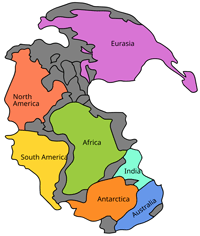
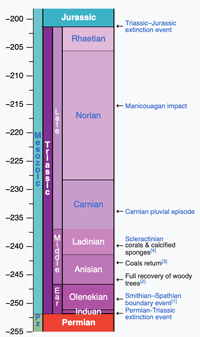
>Top 1. Climate Exchange in Triassic:
- Imagine a world so warm that the ocean feels like a hot tub. Huge volcanic eruptions have pumped the air full of globe-warming carbon dioxide. And with the continents locked together from pole-to-pole in the supercontinent of Pangea, the world is hot, flat, and very, very dry. Early reptiles and mammal ancestors thrive*1 in this sweltering*2 land, dominating a landscape that's still struggling to recover from the Permian extinction.
- This is earth, 250 million years ago, at the beginning of the Triassic Period. But then, starting around 234 million years ago, the climate suddenly changed, for the wetter. The rains finally came to this hot, dry world. And then they stayed ... for two million years. This period of intense rain killed off many of the early reptiles and ... confused the heck*3 out of the geologists who found the flood deposits millions of years later. This time is known as the Carnian Pluvial Episode, and it set the stage for a new group of animals to take over the world: the dinosaurs.
1. 三畳紀の気候変動:
- 世界が熱くなり大洋が、熱い湯船のような状況になることを想像出来ますか。巨大な火山の噴出によって温暖化によるCO2を吹き出した。巨大な大陸は北極から南極まで連なった超大陸パンゲアであり、その世界気候は熱帯で平坦で非常に乾燥していた。初期の爬虫類や哺乳類の先祖は、このような灼熱の環境下で繁栄し、ペルム紀の大絶滅から復活しつつある土地を支配していた。
- この時期は、三畳紀の初期に当たる250百万年前の地球であった。234百万年前になると気候が変動し雨期となった。熱く乾いた世界に雨が降り、それが2百万年も続いたのである。この強烈な降雨は、初期の爬虫類の多くを絶滅させ、後の数百万年に渡る洪水による地形が見つかり地質学者を驚嘆させた。この時期はCPE (カーニアン多雨現象)として知られており、新たな動物種、即ち恐竜が登場する世界となった。
- thrive: prosper, flourish
- swelter: be uncomfortably hot
- heck: expressing surprise, frustration or dismay
>Top 2. The World of Triassic Period: 251.9 - 201.3 ma:
- Evidence of just how hot and dry the world was at the start of the Triassic trapped in the land beneath our feet. Rocks from that period are mostly swarths*1 of red sandstones and soil deposits from dry woodlands, with no sign of the coal swamps that had covered the world during much of the Permian. And one major reason that the world so dry was the shape of Pangea. With all the continents locked together, rain clouds couldn't move much past the coastlines, and there were no big mountain ranges to break up the low, arid land.
- Now, dinosaurs did exist in this dry, post-Permian world. But they were still vying*2 for the place among early reptiles and reptile-like mammal ancestors. The dominant carnivores back then were the early crutotarsans*3, a broad group of croc-like animals that included reptiles like pseudosuchians*4 and phytosaurs*5. For example, there was Ornithosuchus*6, which had long hind legs and could actually stand up when it wanted to run, which I imagine would've been both awesome and terrifying to actually see.
- But even stranger than these were the rhynchosaurs*7, herbivores with parrot-like beaks and, sometimes, cheekbones to die for*8, all on a chubby*9 lizard body. And although there were no true mammals, there were dicynodonts*10 - the closest things to them at the time. They're actually more closely related to us than, say, Dimetrodon*11, despite being scaly*12, four-legged creatures with bills*13 and tusks*14. All of these fascinating creatures were widespread for most of the Triassic, with one species of dicynodon - called Lystrosaurus*15 - being so common all over the world that its fossils were actually used to help construct the idea of Plate Tectonics. But these animals, adapted as they were to life in a dry climate, were in for a big shakeup.
- Most of what we know about the history of the climate comes from plant fossils and rock types. And in the early 1990's, two British geologists found rocks that didn't match the dry climate of the Triassic that they knew. Instead of finding red, slowly-deposited sand, they found thick layers of river rocks, sediments from giant lakes, and evidence of coal swamps. All of these were signs of massive rainfall, over the course of some two million years.
- But stranger still, these traces of a suddenly wet climate turned out to be everywhere, from England to the Americas to Israel, in regions that were far apart at the time. That meant the rise in rainfall must have been world-wide. Initially, other geologists were skeptical. Couldn't these rocks just be explained by a lot of big local floods? Well, over the next two decades, reports of more and more weird*16 rocks kept trickling*17 in, and they kept pointing to a world that was getting wetter and wetter. The rocks revealed coal deposits in Austria, traces of ancient lakes in Italy, wet soils in Utah, and giant rivers in China. And they all dated to the same window of time - between 232 and 234 million years ago.
2. 三畳紀の世界: 251.9 - 201.3百万年前
- 三畳紀の始まりの世界は熱く乾燥した世界であることは当時の地質から明らかである。その時期の岩石の多くは乾燥した植生から生じた赤色砂岩と泥岩であり、ペルム紀に多く見られるような沼地の石炭の兆候は見られない。それは当時のパンゲア超大陸の形状が主な原因である。全ての大陸は連結しており、雨雲は海岸線より奥地には移動することはできず、低い乾燥した土地を隔てる大きな山脈もなかった。
- 実際に、恐竜はペルム紀以降も乾燥した世界に存在していたが、当時は初期の爬虫類や爬虫類的な哺乳類の祖先たちが競合している世界だった。支配的な肉食者は初期の(主竜類の爬虫類である)クルロタルシイ類*3などワニにような陸生のワニや植竜類フィトサウルス*5であった。また鳥類に近い偽鰐類のオルニトスクス*6は長い脚を持ち、走ることもでき、想像するだけで恐ろしい光景だった。
- また奇妙に思えるのはオウムのような嘴をもつ草食性のリンコサウルス*7で、頬骨が発達し、ぽっちゃりとしたトカゲの頬骨が特徴の体格である。真正の哺乳類はいなかったが、当時それに近いのはディキノドン*10である。ディメトロドン*11は鱗に覆われ牙を持ち四足歩行の肉食単弓類である。これらの特徴的な生物は三畳紀を通して広く生息していた。特にディキノドンの一種であるリストロサウルス*15は世界に広範に分布していたので、プレートテクトニクスを考える証拠となっている。これらの動物は乾燥した気候に適応しており、その後大きな変化に見舞われることになる。
- 気候の歴史は植物化石や岩石型によって知ることができる。1990年代初頭に英国の二人の地質学者によって三畳紀の乾燥した気候に合わない岩石を発見した。ゆっくり堆積した赤い砂岩ではなく、川の岩石の厚い層、巨大な湖の堆積物、石炭沼の証拠が見つかった。これらは全て約2百万年に亘る大規模な降雨の兆候であった。
- さらに奇妙なことに、突然の湿潤気候の痕跡は、当時は遠く離れていた英国やアメリカ大陸やイスラエルに至るまであらゆる場所で見つかった、降雨量の増加は世界規模だったことを示す。当初は他の地質学者は懐疑的だった。これらの岩石は、単に局所的な大規模洪水で説明できるのではないかと。その後20年間に、奇妙な岩石が次々と発見され、当時の世界が湿潤化していることを示した。それらの岩石によって、豪州の石炭鉱床、イタリアの古代の湖の痕跡、米国ユタ州の湿潤な土壌、中国の巨大な河川が明らかになった。しかも、それらは全て同時期、即ち232から234百万年前のものであることが判明したのである。
- dark-complexioned黒ずんだ
- vie: compete eargerly wth sb to achieve sth
- crutotarsan: クルロタルシイ類, 主竜類の爬虫類;原生のワニの祖先
- pseudosuchian: 偽鰐類, 陸棲に適応したワニ。肉食
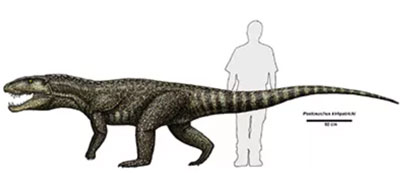
- phytosaur: 植竜類 フィトサウルス類、陸生のワニ。四足での這い歩き。肉食で水中の餌を捕獲

- ornithosuchus: オルニトスクス; 偽鰐類に属する主竜類, 全長4m; 肉食で直立二足歩行、鳥類と近い
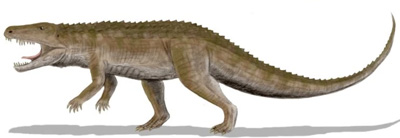
- rhynchosaursリンコサウルス
三畳紀の草食爬虫類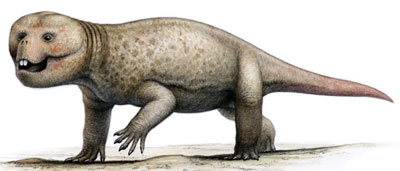
- die for: 欲しくてたまらない
- chubby: plump & rounded, ぽっちゃり
- dicynodonディキノドン:単弓類で 草食、二本の牙のみで歯はない嘴を持つ; 体長1.2m

- dimetrodon: ディメトロドン; 肉食の盤竜目; 体長2-3m; 背に帆の様な棘 (体温調節用)
突き刺す犬歯と切り裂く歯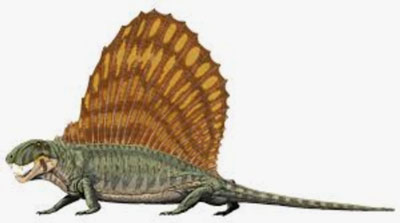
- scaly: 鱗に覆われた
- bill: =beak; くちばし
- tusk: 牙
- lystrosaurus: リストロサウルス; 草食の単弓類 <listron こて; 体長1m; 半水生の動物; 示準化石になる程隆盛
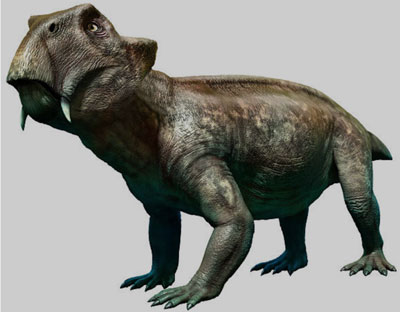
- weird |wiəd|: suggesting sth supernatural
- trickle: flow in a small stream
>Top 3. Carnina Pluvial Episode, CPE:
- In time, this phenomenon came to be known as the Carian Pluvial Episode, or CPE. The Carnian is the name of the geologic age within the Triassic when this all happened. And for what it's worth I seriously thought about naming this episode the Chronicles of Carnia, but I didn't because that would have been dumb. And "pluvial" means rain, and it rained a whole awful lot. For example, one estimate suggest that the average annual rainfall in what's now Utah almost quadrupled, reaching a peak of 1400 millimeters, or about 5 inches of rain a year. For context, that's how much that a temperate rainforest gets today, like say, in the Pacific Northwest. And this would have happened over, and over, and over again, all around the world. It was not one big flood; it was more like floods every year, all over the place, for two million years.
- And with all this rain, things were bound to change - and one the biggest changes was the sudden abundance of dinosaurs. In rock dated to the start of the Carnian Pluvial Episode, dinosaurs account for about 5% of the fossils of terrestrial vertebrates. But by the end, they make up more than 90% of those fossils. So what made the dinosaurs so suddenly successful? Where they better off than their competitors in this newly wet world? Or did other animals simply die, leaving them to rule the world by defaults*1? The key might not have been the rain itself, but what the rain brought with it: a proliferation of giant plants!
- During this time, we begin to see lots of large conifers, and big coal-forming plants, like the primordial-looking Bennettitales*2. For herbivores, this change in food supply could have been a game changer. For example, rhynchosaurs were abundant, but they were also... short. And they couldn't stand on their hind legs to reach higher leaves. This would've been fine in a dry environment, where plants tend to stay close to the ground. But in a wet forest rhynochosaurs would've only been able to eat smaller plants, or whatever leaves and fruit fell to the ground.
- Meanwhile, dicynodonts were herbivores, too, but they didn't have teeth. And, they also didn't use gastroliths, the rocks that some animals - like birds - swallow to help digest plant material. Without teeth or gastroliths, dicynodonts would have had a hard time eating anything fibrous, like wood. And sure enough, fossils of dicynodon poop*3 form this time have been found to contain the digest remains of mostly soft ferns, with only very small amounts of woods. By comparison, some plant-easting dinosaurs - which had both teeth and gasroliths - left us poop fossils that are up to 85% wood, which is a lot of fiber. So as the climate became wetter, soft small ferns were quickly replaced by tall woody conifers*4, which dicynodons and rhynchosaurs didn't eat, and without the rhynchosaurs and dicynodonts, then the carnivores would have lost a lot of their food supply.
3. カーニアン多雨現象, CPE:
- やがてこの現象はCPE(カーニアン多雨現象)として知られるようになった。カーニアンとは三畳紀の中の地質年代の名前である。これをカルニア年代記と名付けようと考えたが、それは良くないのでやめた。多雨とは、本当に沢山の雨が降った。ある推定では、現在の米国ユタ州の年間平均降雨量の約4倍となり、ピーク時には年間1,400 mmに達した。因みにこれは現在の太平洋岸北西部などの温帯雨林の降雨量に匹敵する。これが世界中で、何度も何度も起こった。つまり一回の大洪水ではなく、2百万年に亘って毎年あらゆる場所で洪水が発生したのだった。
- これだけの雨が降れば、物事には大きな変化が起きる。その大きな変化の一つが、恐竜の大量出現である。CPEの初期の岩石では、恐竜は陸上脊椎動物の化石の約5%であったが、CPE末期では、恐竜の化石は化石全体の90%を占める様になった。恐竜はなぜ突然成功したのだろうか。この新たに雨が降った世界で、恐竜は競争相手より有利な状況になったのだろうか。それとも他の動物が単に死に絶えて、恐竜が生き残り世界を支配するようになったのだろうか。鍵となったのは、雨がもたらしたもの、即ち、巨大植物の増殖だったかもしれない。
- この時期には、原始的なベネチタレス*2のような大きな針葉樹や石炭を形成する大きな植物が沢山見られるようになる。草食動物にとっては、この食料供給の変化は状況を多く変えた可能性がある。例えばリンコサウルスの生息数は豊富だったが、背が低かったし、後ろ足で立っても高い所の葉に届くことはできなかった。乾燥した環境では、植物は地面近くに留まる傾向があるので問題はなかった。しかし湿潤な森林では、リンコサウルスは小さな植物または地面に落ちた葉や果実しか食べられなかった。
- 一方、ディキノドン類も草食動物だったが歯なかった。また鳥類など一部の動物が植物の消化を助けるために飲み込んだ石(=胃石)も使用しなかった。歯や胃石がなければディキノドン類は、木材などの繊維質を食べるのに苦労しただろう。そして今回発見されたディキノドンの糞の化石には、ほとんどが柔らかいシダの消化残骸で、木材はごくわずかであることがわかった。比較すると歯と胃石の両方を持っていた一部の草食恐竜は、最大で85%が木材質である糞の化石を残した。これはかなり繊維質である。そのため気候がより湿潤になるにつれて、柔らかて小さなシダはすぐに背の高い木質の針葉樹に置き換えられが、ディキノドン類やリンコサウルス類はそれらを食べなかった。そしてリンコサウルス類やディキノドン類がいなければ、肉食動物は多くの食料を失うことになっただろう。
- by defaut: because of a lack of opposition
- Bennettitales: ベネチテス目; 三畳紀の裸子植物, ソテツ類似

- poop: へとへどになる
- conifer: 針葉樹
>Top 4. Supercontinent Pangea:
- So maybe, instead of being better adapted to this new environment, dinosaurs were just the only major group of reptiles left standing. Or, squatting* even though we don't know exactly why the rain helped the dinosaurs, we do know that dinosaurs became a lot more abundant during the Carnian Pluvial Episode. And the dicynodonts, the rhynchosaurs soon went extinct.
- Now, there's still the question of what made it rain for two million years in the first place? Well, right before the rains came, some 235 million years ago, a huge burst of volcanic activity took place in Alaska and British Columbia. Today it's known as the Wrangellian eruptions. These eruptions lasted for more than 5 million years, churning*3 out a layer of lava that got to be 6 km thick, and releasing enough CO2 to raise temperatures by about 3 to 10 degrees Celsius worldwide. And, over a very long time, warmer temperatures can create a wetter climate, because they can speed up the water cycle, driving more evaporation of surface water into the atmosphere, among other things. And in fact, because of this increase in atmospheric moisture, the CPE is also sometimes called the Carnian Humid Episode. But for what it's worth, my favorite name for this episode by far is The Wet Intermezzo*4. Which I think is delightful so let's try to bring that term back, OK?
- Anyway, after about a million years of volcanic activity, the atmosphere became so warm and wet that rain could finally reach even Pangea's vast interior. OK but then, how did it stop? Well, when carbon levels are really high for a really long time, our plane can be pretty good at getting some of the extra carbon back into the ground where it belongs. Plants take it in and store it in their tissues; weathering and eroding rocks absorb it; and the oceans soak* it up to form carbonate rocks like limestone. So as the Wrangellian eruptions slowed down, the carbon cycle was eventually able to stabilize, excess CO2 was reabsorbed from the atmosphere, and the CPE gradually came to an end.
4. パンゲア超大陸:
- おそらく、恐竜は新しい環境に適応したというより、爬虫の主要グループとして生き残っただけなのかもしれない。あるいは雨が恐竜を助けた理由は」正確にはわからないな、CPEの多雨期に恐竜の数が大幅に増えたことはわかっている。そしてディキノドン類、リンコサウルス類はまもなく絶滅した。
- そもそもなぜ2百万年も雨が降ったのかという疑問が残る。雨が降り出す直前の約235百万年前にアラスカとかダダBC州で大規模な火山活動が起こった、今日ではランゲリアン噴火として知られている。この噴火は5百万年以上続き、暑さ6kmの溶岩層を噴出し、世界の気温を約3〜10ºC上昇させるのに十分なCO2を放出した。そして非常に長い時間をかけて気温が上昇すると、水の循環が加速し地表水が大気中に蒸発することで、より湿潤な気候が生じる。実際に大気中の湿度が増加するので、CPEはCarnian Humid Episodeとも呼ばれることがある。しかし私のお気に入りの名称は"The Wet Intermesso, 湿潤間奏曲"である。今後はその用語を復活させたいと思う。
- いずれにせよ約1百万年に亘る火山活動の結果、大気は非常に暖かく湿潤になり、雨がついにはパンゲア超大陸の内部にまで届くようになった。ではその後どのようにしてそれは止まったのか。CO2レベルが非常に長期間に亘って高濃度の場合、地球は余分なCO2の一部を本来あるべき場所である地中に戻す傾向が増える。植物はそれを取り込み組織に蓄える。風化や侵食によって岩石がそれらを吸収する。海洋はまたそれを吸収して石灰岩など炭酸塩岩を形成する。こうしてランゲリアン噴火が沈静化するにつれて、炭素循環は最終的に安定し、過剰なCO2は大気から再吸収され、CPEは徐々に終了していった。
- ルルロタルシ類: 主竜類のワニ
- squat: crouch or sit; しゃがむ
- churn: shake in a machine
- intermezzo -zi: 間奏曲; 幕間演芸
- soak: become thoroughly wet by immersing it in liquid; 浸す、つける
>Top 5. Only 2 Million Years of CPE:
- By the time the eruptions had completely ended 230 million years ago, the world had returned to a classically hot, dry Triassic climate that only ended when Pangea began to break up. But even though the CPE was short -only 2 million years - its impacts on life were permanent. All that rainfall helped conifers spread and diversify, leading to the pine tress we know today. And while the start of the Triassic may have been the land of weird, croc-like-things running on their hind legs by the time the rains had ended, the world had fully entered the age of dinosaurs.
5.CPEはわずか200万年:
- 230百万年前に噴火が完全に収束した頃には、世界は再び暑く乾燥した三畳紀の気候に戻り、パンゲア超大陸が分裂し始めた頃にようやくその気候は終わりを迎ええた、しかしCPEはわずか2百万年と短かったが、生命への影響は永続的だった。大量の雨が針葉樹の拡散と多様化をもたらし、今日我々が知っている松の木が生まれた。三畳紀の始まりはワニのような奇妙が生き物が後ろ足で走るような世界であったが、雨が終わることには世界は完全に恐竜の時代に入っていった。
>Top 6. Geological Evidence:
- Siliciclastic (Si-rich) sediment in sedimentary basins, reflecting continental weathering and runoff.
- significant karst conduits (caves) in Palaeozoic limestone inliers beneath Triassic terrestrial unconformity.
- fossil soils which are typical of a tropical humid climate with more water entering through precipitation.
- fossil pollen assembles that reflect vegetation more adapted to a humid climate.
- wide spred presence of amber.
- Mn ion in limestone: Mn ions are concentrated and soluble in deep euxinic waters, but precipitate in carbonates at the base of the oxygenated zone. Increasing Mn concenrations indicated corresponding expansion of euxinic (anoxic) water.
- δ18O: Global warming was prevalent; which is evidenced by oxygeng isotope analyses of conodont apatite, showing 1.5‰ negative shift of δ18O, suggesting global warming 3-4ºC.
- δ13C: sediments in CPE show -2 to -4‰ δ13C excursion, indicationg lighter C-12 into the atomosphere.
- Osmium: relative abundance of Os-187 over Os-188 through most of Julian. Os-188 is sourced directly from the mantle, while Os-187 is a radiogenic isotope supplied from eroded land.
- Mercury: Hg is initially derived from a pulse of volcanic activity, particularly the Wrangellia LIP (Large Igneous Province). Hg enrichments are related to the multiple eruption of the Wrangellia LIP.
6. 地質学的な証拠:
- 多珪質の堆積盆が大陸の風化作用による岩石の流出
- 三畳紀の陸上不整合の下の古生代岩体中の石灰岩カルスト(洞窟)の存在
- 熱帯湿潤気候に特徴的な降雨のよる化石層の存在
- 湿潤気候の植生を反映した花粉化石の存在
- 広範な琥珀の存在
- δ18O: [雨水は16Oが豊富、凝結すると18O比が増える。δ18Oの0.22‰上昇=1ºC降下]
- δ13C: CPEの堆積岩は1-2から-4‰であり、これは軽いC-12の空気中への移動を示す。
- Os: Carnianの上部のJulina層ではOs-187/Os-188比が相対的に増加。Os-188はマントルから直接供給され、Os-187は風化のよる放射性崩壊起源。
- Hg: Hgは火山活動、特にWrangellia巨大火成岩岩石区(LIP)で濃集。これは活発中桟噴出を示す
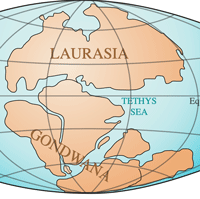
Laurasia continent 200Ma
>Top 7. xxxx:
>Top 8. xxxx:
>Top 9. xxxx:
9. xxxx:
>Top10. xxxx:
10. xxxx:
>Top11. xxxx:
11. xxxx:
Comment
- a
- a
|
The Carnian Pluvial Episode, CPE-That Time It Rained for 2M Years -
|
Cat: SCI |
PBS EONS |
249080u |
Title |
The Carnian Pluvial Episode, CPE | |
|---|---|---|
Index |
||
Tag |
Source (2024/9): https://www.youtube.com/watch?v=_1LdMWlNYS4; | |
Why |
|
|
Category |
LaTeX command |
LaTeX Sample |
>Top 0. Preface:
|
12. 序文:
|
Pangaea (Pangea) |pændʒíːə|
|
 |
>Top 1. Climate Exchange in Triassic:
|
1. 三畳紀の気候変動:
|
|
>Top 2. The World of Triassic Period: 251.9 - 201.3 ma:
|
2. 三畳紀の世界: 251.9 - 201.3百万年前
|
|
>Top 3. Carnina Pluvial Episode, CPE:
|
3. カーニアン多雨現象, CPE:
|
|
>Top 4. Supercontinent Pangea:
|
4. パンゲア超大陸:
|
|
>Top 5. Only 2 Million Years of CPE:
|
5.CPEはわずか200万年:
|
>Top 6. Geological Evidence:
|
6. 地質学的な証拠:
|
 Laurasia continent 200Ma |
>Top 7. xxxx: |
||
>Top 8. xxxx: |
||
>Top 9. xxxx: |
9. xxxx: |
>Top10. xxxx: |
10. xxxx: |
>Top11. xxxx: |
11. xxxx: |
Comment |
|
|